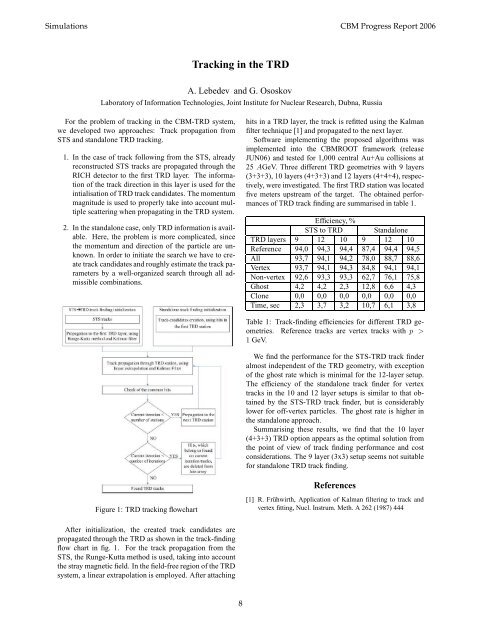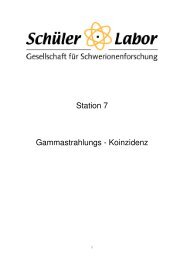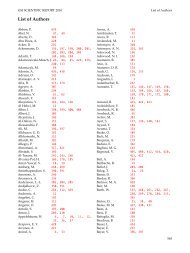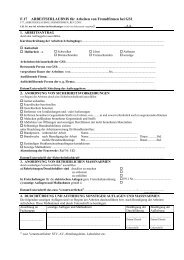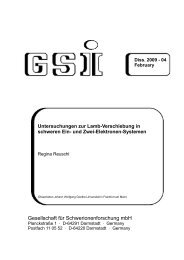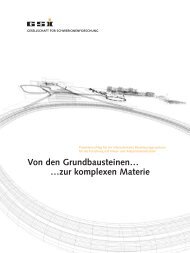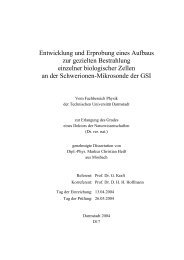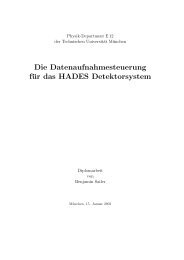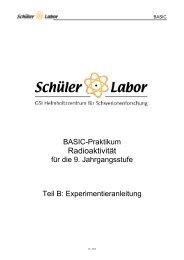CBM Progress Report 2006 - GSI
CBM Progress Report 2006 - GSI
CBM Progress Report 2006 - GSI
You also want an ePaper? Increase the reach of your titles
YUMPU automatically turns print PDFs into web optimized ePapers that Google loves.
Simulations <strong>CBM</strong> <strong>Progress</strong> <strong>Report</strong> <strong>2006</strong><br />
Tracking in the TRD<br />
A. Lebedev and G. Ososkov<br />
Laboratory of Information Technologies, Joint Institute for Nuclear Research, Dubna, Russia<br />
For the problem of tracking in the <strong>CBM</strong>-TRD system,<br />
we developed two approaches: Track propagation from<br />
STS and standalone TRD tracking.<br />
1. In the case of track following from the STS, already<br />
reconstructed STS tracks are propagated through the<br />
RICH detector to the first TRD layer. The information<br />
of the track direction in this layer is used for the<br />
intialisation of TRD track candidates. The momentum<br />
magnitude is used to properly take into account multiple<br />
scattering when propagating in the TRD system.<br />
2. In the standalone case, only TRD information is available.<br />
Here, the problem is more complicated, since<br />
the momentum and direction of the particle are unknown.<br />
In order to initiate the search we have to create<br />
track candidates and roughly estimate the track parameters<br />
by a well-organized search through all admissible<br />
combinations.<br />
Figure 1: TRD tracking flowchart<br />
After initialization, the created track candidates are<br />
propagated through the TRD as shown in the track-finding<br />
flow chart in fig. 1. For the track propagation from the<br />
STS, the Runge-Kutta method is used, taking into account<br />
the stray magnetic field. In the field-free region of the TRD<br />
system, a linear extrapolation is employed. After attaching<br />
8<br />
hits in a TRD layer, the track is refitted using the Kalman<br />
filter technique [1] and propagated to the next layer.<br />
Software implementing the proposed algorithms was<br />
implemented into the <strong>CBM</strong>ROOT framework (release<br />
JUN06) and tested for 1,000 central Au+Au collisions at<br />
25 AGeV. Three different TRD geometries with 9 layers<br />
(3+3+3), 10 layers (4+3+3) and 12 layers (4+4+4), respectively,<br />
were investigated. The first TRD station was located<br />
five meters upstream of the target. The obtained performances<br />
of TRD track finding are summarised in table 1.<br />
Efficiency, %<br />
STS to TRD Standalone<br />
TRD layers 9 12 10 9 12 10<br />
Reference 94,0 94,3 94,4 87,4 94,4 94,5<br />
All 93,7 94,1 94,2 78,0 88,7 88,6<br />
Vertex 93,7 94,1 94,3 84,8 94,1 94,1<br />
Non-vertex 92,6 93,3 93,3 62,7 76,1 75,8<br />
Ghost 4,2 4,2 2,3 12,8 6,6 4,3<br />
Clone 0,0 0,0 0,0 0,0 0,0 0,0<br />
Time, sec 2,3 3,7 3,2 10,7 6,1 3,8<br />
Table 1: Track-finding efficiencies for different TRD geometries.<br />
Reference tracks are vertex tracks with p ><br />
1 GeV.<br />
We find the performance for the STS-TRD track finder<br />
almost independent of the TRD geometry, with exception<br />
of the ghost rate which is minimal for the 12-layer setup.<br />
The efficiency of the standalone track finder for vertex<br />
tracks in the 10 and 12 layer setups is similar to that obtained<br />
by the STS-TRD track finder, but is considerably<br />
lower for off-vertex particles. The ghost rate is higher in<br />
the standalone approach.<br />
Summarising these results, we find that the 10 layer<br />
(4+3+3) TRD option appears as the optimal solution from<br />
the point of view of track finding performance and cost<br />
considerations. The 9 layer (3x3) setup seems not suitable<br />
for standalone TRD track finding.<br />
References<br />
[1] R. Frühwirth, Application of Kalman filtering to track and<br />
vertex fitting, Nucl. Instrum. Meth. A 262 (1987) 444


